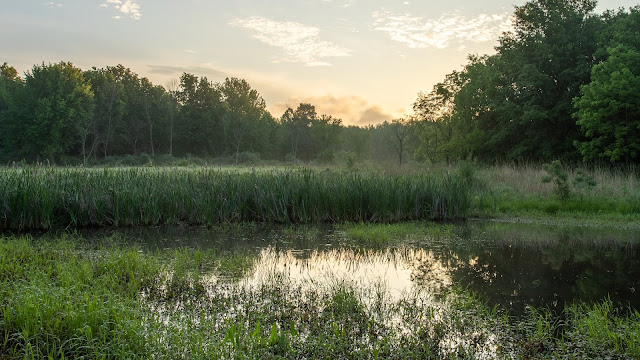If You Build It...
 |
| The Wonderful Wetland, June 8, 2021 shortly after sunrise |
It may surprise you to know that fifteen years ago this wonderful, magical, glorious wetland, which I've spent the last eight months marveling at and blogging about, did not exist except on paper. The Homer Lake Wetland I am so fascinated with is a wetland restoration proposed by the Champaign County Forest Preserves and partially funded by a Five Star Restoration Challenge Grant awarded by the National Association of Counties in July, 2006. The photo below shows the site of the proposed wetland in September 2006 before any work had begun. You may recognize the tree at the right in the photo below as the now dead snag standing on the east edge of the wetland visible in many of the photos of the wetland I have posted, a favorite perch for bluebirds and flycatchers watching for flying insects emerging from or attracted to the wetland. Likewise, bluebird nesting box number seven at the bottom left of the photo below still stands between the parking lot and the south edge of the wetland.
 |
| The (then) Future Site of the Proposed Homer Lake Wetland Restoration, September 2006 |
According to a September 17, 2007 News Gazette Article, this portion of the forest preserve, referred to as "the Middle Meadow," had been farmed up until 1960 or so when it was turned into a state tree nursery. As a state tree nursery during the 60's, autumn olive and multiflora rose, both shrubs now known to be aggressive invasives harmful to native habitats, were planted in the area with the [misguided] intention of fixing nitrogen in the soil and providing habitat. This resulted in much work to be done in the 90's to remove both of these plants, as evidenced in the photo above where neither plant remains.
 |
| Working on the Wetland, June 18, 2007 |
Work on the wetland was completed throughout 2007, per the terms of the grant, so its first season functioning as a wetland was fall 2007 into 2008, as seen below.
 |
| The Wetland, January 7, 2008 |
 |
| Scads of Tadpoles Already, May 27, 2008! |
I marvel at the rich diversity of life now inhabiting the wetland knowing it is only in its fourteenth year. Where did it all come from? The area was diligently seeded with a rich variety of appropriate plants, both wetland and prairie, in 2007, but what about all of the animal life? In the photo above you can see that even in its first year it was a hotspot for at least one species of frog. Still, this year I observed ten amphibian species breeding in the wetland (nine frog species and one salamander species), including a new county record for the northern leopard frog. Apart from the northern leopard frogs -- no one is quite sure how they got here -- the other amphibian species were quite likely present elsewhere in the forest preserve but have found the wetland a great place to "raise a family." Similarly, the five species of reptiles (two snake species, three turtle species) I've observed at the wetland this season were certainly already present in the preserve. Unlike the amphibians making use of the wetland for reproduction, the reptiles find it a great place to hang out and have dinner -- in the case of the snakes and the snapping turtle no doubt, dining on the abundant amphibian population!
In the mid-western farm belt states, over 36 million acres of wetlands have been lost or degraded since pre-settlement time. Therefore, the need to create and enhance and protect wetlands in Illinois is necessary. The Champaign County Forest Preserve (CCFPD) owns an 800+ acre area known as the Homer Lake Forest Preserve near Homer, Illinois. The Preserve provides recreational and educational activities for thousands of individuals each year. With miles of river corridor, an 80 acre lake, and acreage set aside specifically for wildlife conservation, it is one of the premier natural areas on the county. This setting provides the perfect opportunity for a wetland restoration that would have a significant positive impact on the ecological, educational, recreational, and socio-economical actives in the area.
Yes. And if you build it, "they" -- lots and lots of them -- will come.
special thanks to CCFPD staff Mike Daab, Brian Taylor, Peter Goodspeed and Jennifer Wick for background information and historic photos for this post, not to mention their (and others') involvement in making the wetland a reality!



Comments
Post a Comment